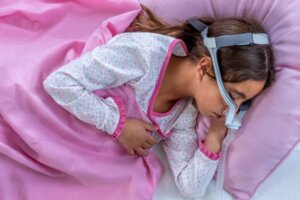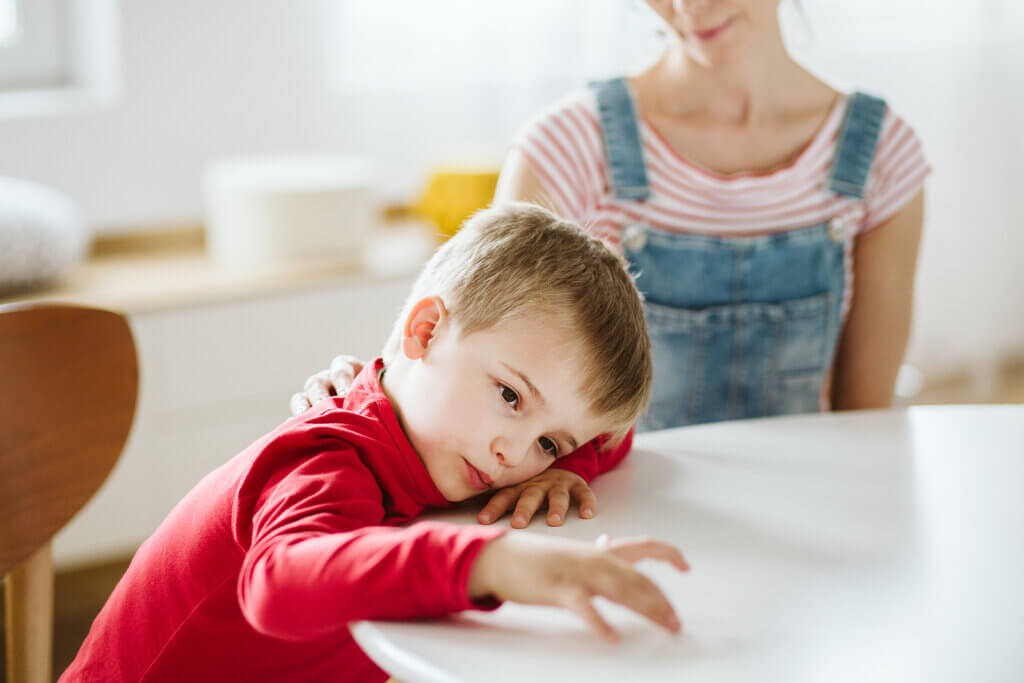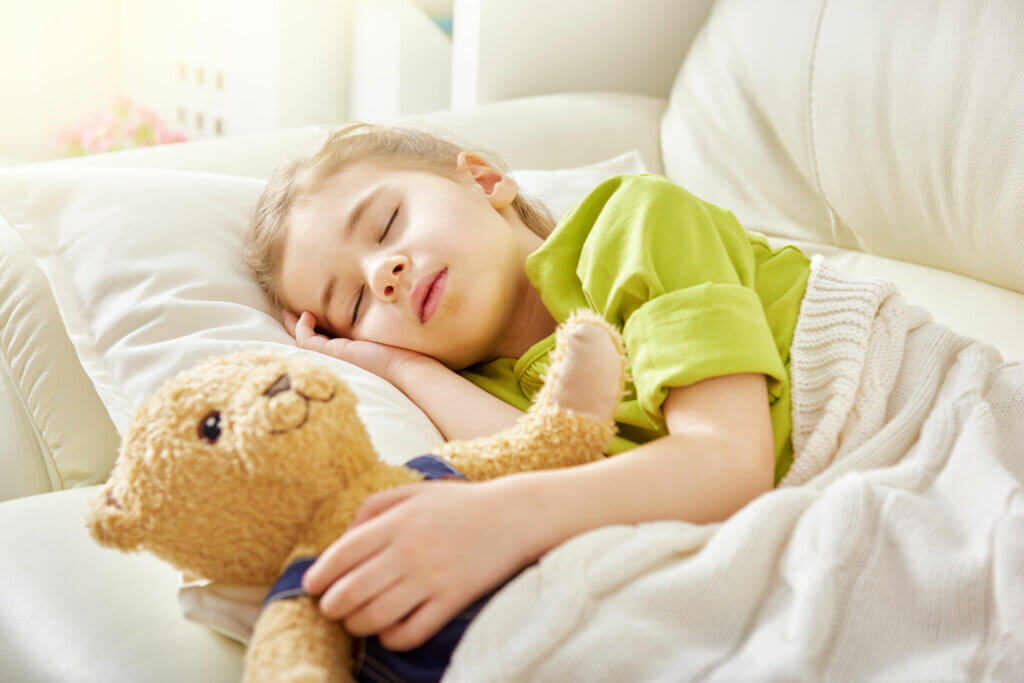Sleep Apnea in Children: What You Need to Know

Sleep disturbances are very common both in childhood and adulthood. One of the diseases that have a high incidence is sleep apnea in children. Unfortunately, identifying this disease is very difficult.
Sleep apnea is the partial or total obstruction of the upper airways that occurs when children sleep. The obstruction will lead to the momentary cessation of breathing, which should last at least 10 seconds.
Both the causes and the clinical manifestations of sleep apnea in children are very different from those presented by adults. The prevalence of sleep apnea in childhood is estimated to be 2% to 3%. However, the disorder is often misdiagnosed.
Symptoms
The symptoms of sleep apnea in children can be difficult to identify, especially in young children. The disease involves both diurnal and nocturnal manifestations. Nighttime symptoms are due to the obstruction itself, while daytime symptoms are associated with poor-quality sleep.
The main nocturnal symptom that points to the presence of sleep apnea is snoring. Snoring appears as a result of the difficulty that air encounters when passing through the airways. The noise generated by snoring is often loud, staccato, and very similar to choking.
Other clinical manifestations that may appear at night are the following:
- Restless sleep
- Profuse sweating
- The presence of abdominal respiratory movements
- Noisy breathing
- Enuresis (bed wetting)
- Abnormal postures when sleeping
- Frequent nocturnal awakenings
At the same time, behavioral disturbances are the main daytime symptom of sleep apnea in children. Other clinical manifestations that can be found during the day are the following:
- Drowsiness or hyperactivity
- Poor school performance
- Headaches in the morning
- Irritability, bad mood, or impatience
- Difficulty paying attention
- Little weight gain

Causes of sleep apnea in children
The throat has a series of muscles that help keep it open and allow for proper airflow. All these muscles relax during sleep, so the diameter of the throat decreases considerably during this period.
Under normal conditions, the throat has a diameter that allows air to pass through smoothly during sleep. Sleep apnea in children appears when there’s some alteration that further reduces the diameter of the throat.
The main cause of this disease is the increase in the size of the tonsil tissue or the tonsils, according to multiple studies. At the same time, there are multiple alterations that are also capable of causing the alteration:
- Congenital modifications of the skull or face
- A large tongue that can retract and obstruct the throat
- Childhood obesity
- Small jaws
- Allergic rhinitis
- Neuromuscular diseases
- Laryngomalacia
Possible consequences
The consequences of sleep apnea in children vary greatly and will depend on the magnitude of the situation. Complications can range from a decline in school performance to stunted growth. All are due to the destructuring of sleep caused by the disease.
Research that talks about the long-term consequences of the disease in children is very limited. Some of the studies carried out associate sleep apnea with the following alterations:
- Changes in the function of the heart
- Arterial hypertension
- Behavior problems
- Alterations in memory
- Stunted growth
- Attention deficit hyperactivity disorder
- Depression
The diagnosis of sleep apnea in children
The diagnosis of sleep apnea in children is made through medical history and complementary tests. The doctor will ask the parents about the characteristics of snoring and periods of apnea. They’ll also inquire about the presence of daytime symptoms and family history.
The findings upon physical examination are very varied. The doctor will examine the throat for an obvious sign of obstruction, such as tonsillitis. In addition, they’ll perform a systematic examination of the whole body in search of any disease that explains the syndrome.
The ideal test to diagnose sleep apnea in children is polysomnography. This is a study that evaluates children’s sleep at night, using sensors applied to the body to measure brain waves.
Polysomnography can also detect oxygen levels, heart rate, and muscle activity while children sleep. Other tests, such as oximetry or an electrocardiogram during sleep, can also help.

Treatment
Treatment for sleep apnea in children will depend on the precise cause. Removing the structural obstruction will easily resolve the situation. In this regard, surgical removal of the tonsils solves the problem in up to 75% of cases, according to some research.
Mild cases of sleep apnea can be treated with topical nasal steroids, which are intended to deflate the airways. In addition, the use of antiallergic drugs has shown favorable results.
Lastly, continuous positive pressure in the upper airways can also definitively resolve the condition. The therapy consists of the implementation of masks that send air to the back of the throat. The idea is to maintain the airways when surgery doesn’t offer the expected results.
A common disease that goes unnoticed
Sleep apnea in children is a disorder that can easily go unnoticed, especially in infants. Parents should be vigilant in the presence of snoring or any nocturnal symptoms that indicate the presence of the disease.
Fortunately, there are techniques such as polysomnography that diagnose this sleep disorder quickly and accurately. Furthermore, the surgical approach is the definitive solution in most cases. If you have any doubts or suspicions, it’s best to seek medical attention immediately.
Sleep disturbances are very common both in childhood and adulthood. One of the diseases that have a high incidence is sleep apnea in children. Unfortunately, identifying this disease is very difficult.
Sleep apnea is the partial or total obstruction of the upper airways that occurs when children sleep. The obstruction will lead to the momentary cessation of breathing, which should last at least 10 seconds.
Both the causes and the clinical manifestations of sleep apnea in children are very different from those presented by adults. The prevalence of sleep apnea in childhood is estimated to be 2% to 3%. However, the disorder is often misdiagnosed.
Symptoms
The symptoms of sleep apnea in children can be difficult to identify, especially in young children. The disease involves both diurnal and nocturnal manifestations. Nighttime symptoms are due to the obstruction itself, while daytime symptoms are associated with poor-quality sleep.
The main nocturnal symptom that points to the presence of sleep apnea is snoring. Snoring appears as a result of the difficulty that air encounters when passing through the airways. The noise generated by snoring is often loud, staccato, and very similar to choking.
Other clinical manifestations that may appear at night are the following:
- Restless sleep
- Profuse sweating
- The presence of abdominal respiratory movements
- Noisy breathing
- Enuresis (bed wetting)
- Abnormal postures when sleeping
- Frequent nocturnal awakenings
At the same time, behavioral disturbances are the main daytime symptom of sleep apnea in children. Other clinical manifestations that can be found during the day are the following:
- Drowsiness or hyperactivity
- Poor school performance
- Headaches in the morning
- Irritability, bad mood, or impatience
- Difficulty paying attention
- Little weight gain

Causes of sleep apnea in children
The throat has a series of muscles that help keep it open and allow for proper airflow. All these muscles relax during sleep, so the diameter of the throat decreases considerably during this period.
Under normal conditions, the throat has a diameter that allows air to pass through smoothly during sleep. Sleep apnea in children appears when there’s some alteration that further reduces the diameter of the throat.
The main cause of this disease is the increase in the size of the tonsil tissue or the tonsils, according to multiple studies. At the same time, there are multiple alterations that are also capable of causing the alteration:
- Congenital modifications of the skull or face
- A large tongue that can retract and obstruct the throat
- Childhood obesity
- Small jaws
- Allergic rhinitis
- Neuromuscular diseases
- Laryngomalacia
Possible consequences
The consequences of sleep apnea in children vary greatly and will depend on the magnitude of the situation. Complications can range from a decline in school performance to stunted growth. All are due to the destructuring of sleep caused by the disease.
Research that talks about the long-term consequences of the disease in children is very limited. Some of the studies carried out associate sleep apnea with the following alterations:
- Changes in the function of the heart
- Arterial hypertension
- Behavior problems
- Alterations in memory
- Stunted growth
- Attention deficit hyperactivity disorder
- Depression
The diagnosis of sleep apnea in children
The diagnosis of sleep apnea in children is made through medical history and complementary tests. The doctor will ask the parents about the characteristics of snoring and periods of apnea. They’ll also inquire about the presence of daytime symptoms and family history.
The findings upon physical examination are very varied. The doctor will examine the throat for an obvious sign of obstruction, such as tonsillitis. In addition, they’ll perform a systematic examination of the whole body in search of any disease that explains the syndrome.
The ideal test to diagnose sleep apnea in children is polysomnography. This is a study that evaluates children’s sleep at night, using sensors applied to the body to measure brain waves.
Polysomnography can also detect oxygen levels, heart rate, and muscle activity while children sleep. Other tests, such as oximetry or an electrocardiogram during sleep, can also help.

Treatment
Treatment for sleep apnea in children will depend on the precise cause. Removing the structural obstruction will easily resolve the situation. In this regard, surgical removal of the tonsils solves the problem in up to 75% of cases, according to some research.
Mild cases of sleep apnea can be treated with topical nasal steroids, which are intended to deflate the airways. In addition, the use of antiallergic drugs has shown favorable results.
Lastly, continuous positive pressure in the upper airways can also definitively resolve the condition. The therapy consists of the implementation of masks that send air to the back of the throat. The idea is to maintain the airways when surgery doesn’t offer the expected results.
A common disease that goes unnoticed
Sleep apnea in children is a disorder that can easily go unnoticed, especially in infants. Parents should be vigilant in the presence of snoring or any nocturnal symptoms that indicate the presence of the disease.
Fortunately, there are techniques such as polysomnography that diagnose this sleep disorder quickly and accurately. Furthermore, the surgical approach is the definitive solution in most cases. If you have any doubts or suspicions, it’s best to seek medical attention immediately.
- Villafruela Sanz M. Síndrome de apnea del sueño en el niño. Anales de pediatría. 2003; 1(S1): 69-71.
- Villa Asensi J, Martínez Carrasco C, Pérez Pérez G, Cortell Aznar I et al. Síndrome de apneas-hipopneas del sueño. Protocolos Diagnóstico Terapeúticos de la AEP: Neumología. 2008.
- Gómez Ayala A. Síndrome de la apnea obstructiva del sueño. Impacto en la edad pediátrica. Offarm. 2008; 27(11): 62-67.
- Gipson K, Lu M, Kinane TB. Sleep-Disordered Breathing in Children. Pediatr Rev. 2019 Jan;40(1):3-13. doi: 10.1542/pir.2018-0142. Erratum in: Pediatr Rev. 2019 May;40(5):261.
- Li Z, Celestin J, Lockey RF. Pediatric Sleep Apnea Syndrome: An Update. J Allergy Clin Immunol Pract. 2016 Sep-Oct;4(5):852-61.
- Sans-Capdevila O, Gozal D. Consecuencias neurobiológicas del síndrome de apnea del sueño infantil. Rev Neurol. 2008 Dec 16-31;47(12):659-64.
Este texto se ofrece únicamente con propósitos informativos y no reemplaza la consulta con un profesional. Ante dudas, consulta a tu especialista.







